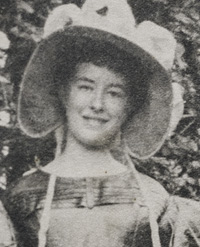Sarah Gibson Flandrau Cutcheon
(1866 – 1947)
 Sarah G. Flandrau, nicknamed "Sally" in her infancy, was born at the Dinsmore home on December 4, 1866, the daughter of Isabella and Charles E. Flandrau. Named after her mother’s best friend, she was motherless at the age of seven months and was raised, almost solely, by her Aunt Julia Dinsmore, whom she lovingly referred to as her “owny mommy.” Julia coddled and protected her “precious own,” causing Sally to develop a more selfish and needy personality than her sister, Patty, who was five years older. Her childless marriage doubtless exacerbated her tendency to focus on herself, although her husband’s generosity to his extended family helped to soften Sally’s rather stingy attitude. While she socialized with the elite of New York City, by the end of her life she had few close friends and had isolated herself within her home, refusing to see anyone.
Sarah G. Flandrau, nicknamed "Sally" in her infancy, was born at the Dinsmore home on December 4, 1866, the daughter of Isabella and Charles E. Flandrau. Named after her mother’s best friend, she was motherless at the age of seven months and was raised, almost solely, by her Aunt Julia Dinsmore, whom she lovingly referred to as her “owny mommy.” Julia coddled and protected her “precious own,” causing Sally to develop a more selfish and needy personality than her sister, Patty, who was five years older. Her childless marriage doubtless exacerbated her tendency to focus on herself, although her husband’s generosity to his extended family helped to soften Sally’s rather stingy attitude. While she socialized with the elite of New York City, by the end of her life she had few close friends and had isolated herself within her home, refusing to see anyone.
In looks, it is difficult to tell who exactly Sally resembled. The pretty, red-haired Patty looked like her mother, Isabella, but Sally, with light brown hair, narrow eyes, and flat face, appears rather homely in her childhood pictures. Although she later blossomed into a beautiful young woman, perhaps her appearance – in addition to her asthma – helped to convince Julia that her little niece was not going to have a long life. Julia kept the her “precious own” at home, refusing to allow her to walk to school until she was twelve years old, and wrote to Patty, “The poor little thing is one of those whom the gods love, I believe, and we must do the best we can for her while we have her.”1 Although Julia did do her best for Sally, it did not draw the young girl closer to her. While her letters to her aunt indicate that Sally had a deep love and respect for the older woman, she did not show the empathy for Julia that Patty did. Instead her thoughts were primarily consumed with her parties, dresses, friends, and travels. She did spend a few weeks every year with Julia but it seemed to be more of a chore for her than it was for Patty.
When Sally was fourteen years old, she followed Patty to Miss Nourse’s school in Cincinnati, but she returned home before a month was out. One suspects that her lack of traditional schooling may have resulted in her inability to feel comfortable in the rigorous atmosphere at Miss Nourse’s. The following spring, she and Julia decided that she would attend Miss Porter’s school for young ladies in Farmington, Connecticut, a prestigious school that a few of the girls she met in St. Paul attended. She did much better in this atmosphere and had no trouble making friends. Julia constantly wrote her, warning Sally about studying too much and what it might do to her eyes. In return, Sally often complained about problems with her eyes and having to rest them. Although ocular problems were worrisome in a time period when doctors could do so little outside of recommending spectacles (which Sally used), her problems seem to have been uncommonly troublesome and may have resulted other factors, such as the shape of her eyes. In 1884, a friend from school wrote her,
You poor little you what are you good for? I suppose it is very nice to have beautiful eyes, different from everyone else’s and all that but really I would almost rather have ordinary ones like my own and have them not trouble me, than to have the time you have had.2
Sally’s eyes and her asthma appear to have bothered her most of her life, although the attention showered on her by her aunt may have caused her to exaggerate her illnesses. Later in her life, others began to tire of her neediness and to suspect that perhaps she was not as ill as she thought she was. Her niece, Isabella Ferguson, found Sally to be an unreliable relative whose recurring illnesses kept her husband, Frank, from enjoying a full life. Isabella did not have the patience “with the necessity of holding [Sally’s] hand every two minutes & not being able to depend on her at all.”3
Sally’s homeliness in her youth transformed into a belle’s beauty by the time she had completed her studies at Miss Porter’s. Spending more of her time in cosmopolitan St. Paul, her social life consumed her time, dancing till the early hours of the morning and rising from bed a little before noon. Patty wrote that her sister was “universally given up to be ‘the best behaved, the best dressed, and the prettiest girl in the room,’” and that her father, Charles, was “as proud as a ‘dog with two tails’” over his youngest daughter’s social success.4 This success in society translated into several beaux, which was the goal of every young woman. The first to actively court Sally was Will Armstrong, who visited her in Boone County and who later shot a bull elk, making a gift to her of the rack. Sally forwarded the elk to Julia Dinsmore, informing her that she had never seen it, “but thought it might look well in the hall at Boone,” where it hangs today.5 Will tried, without success, to woo Sally through her relatives when she showed little interest herself. While Patty and Julia both favored Will above all her beaux, for some reason Sally could not bring herself to accept him.
Instead, it was Frank Cutcheon who eventually stole Sally’s heart and the two were married on February 5, 1891, in an Episcopal Church. Frank’s financial situation was quite secure and he had been made a senior partner in Charles Flandrau’s law firm at the age of twenty-two – this may have attracted Sally to him. Neither Patty nor Julia cared much for Frank initially (Julia resolved to “lump him”), but over the years both women became dependent on his knowledge of legal and financial matters and came to view him in a more favorable light. He took on the role of Sally’s protector and stayed by her side whenever she suffered from mental or physical illness. After living in St. Paul for several years, Frank and Sally moved to New York City, where the couple had a home in the city and another in Locust Valley. Although they never had a single financial worry, and it was rumored in St. Paul that Frank had made a quarter of a million dollars on commodities in 1900, Sally still acted as though she were strapped for money.6 Opening her home to her sister and niece, Sally confided to her “owny mommy” that it was going to be a “disappointment to Patty to find how careful I have to be, and how I have to watch expenses & keep them down.... I hope for the best and will do all I can to make them feel we are glad to share what little we have with them.”7
Sally’s view of the world seems very outdated in this day and age. Writing to the head of a group that wanted to create an interracial program to ease tensions after World War Two, Sally explained her beliefs, “I think people are born Catholic or Protestant, Republican or Democratic just as they are born doctors and Poets,” and superior and inferior, she might have added. She refused to give money to a program when she considered racial tensions a problem for the states to manage.8 African Americans were, by nature, only capable of certain behaviors, in her view. When a black tenant left without paying rent, she attributed it to “the irresponsibility of his race rather than to any intentional misdoing,” leaving herself little room to imagine any sort of progress in race relations.9 Her father’s death in 1903 hit Sally particularly hard, especially when she discovered that he had decided to let his wife divide his legacy, leaving Sally nothing until Rebecca’s death. Frank agonized over a potential mental meltdown and begged Julia to come for a visit. After she had returned to Boone, he wrote her:
“What she needs is somebody who cares for her & who she knows cares for her to be with her constantly, to hold her up with the consciousness of affection & that life is worth while, until she has safely passed this period of depression, which in the feature of her despair of self, amounts almost to melancholia.”
Sally eventually recovered but she rarely contacted her Flandrau relatives again. It was Julia Dinsmore that Sally regarded as her true parent and she tried to make the older woman’s life as easy as her money could, updating the farmhouse by installing plumbing and building on a modern kitchen. When she inherited the farm in 1926, after Julia’s death, she managed from afar, and occasionally visited. After several years of ill health, she died in Santa Barbara on the 18th of June, 1847 at the age of eighty. According to her wishes, her body was cremated and her ashes were interred with those of her husband in the Dinsmore family graveyard.
2 B.G. to Sally Flandrau, 31 July 1884.
3 Isabella S. Ferguson to Patty F. Selmes, 21 July 1921.
4 Patty F. Selmes to Julia Dinsmore, 10 October 1885.
5 Sally Flandrau to Julia Dinsmore, n.d. 1887.
6 Patty F. Selmes to Julia Dinsmore, 5 July 1900.
7 Sally F. Cutcheon to Julia Dinsmore, 25 October 1901.
8 Sally F. Cutcheon to Dorothy Thompson, 13 October 1945.
9 Sally F. Cutcheon to L.F. Thompson, 18 April 1942.
